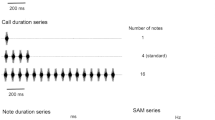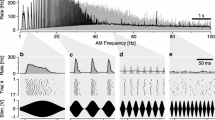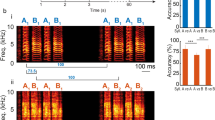Abstract
By examining the mechanical properties of the tympanum of the noctuid moth, Noctua pronuba, Windmill et al. (2006) suggested that this insect increases (up-tunes) the frequencies of its best hearing when exposed to high intensity sounds (HIS) resembling the echolocation calls of attacking bats. We tested whether this biophysical phenomenon was encoded in the neural responses of this moth’s most sensitive auditory receptor (A1 cell) before and after exposure to HIS. We measured: (1) the number of A1 action potentials (spikes) per stimulus pulse; (2) the proportion of A1 spike periods below that determined to elicit evasive flight maneuvers and, (3) the change in A1 cell firing (spike number, interspike interval, stimulus/spike latency) over a duration of time similar to that in which up-tuning lasts. We observed no significant spiking response changes in the predicted direction to any of the frequencies tested following exposure to HIS and we observed only two of the 24 predicted time-dependent changes to A1 firing. These results indicate that tympanal up-tuning does not result in a change to this moth’s auditory frequency sensitivity and we suggest either sensillar resonances or increases in thoracic muscle tension following exposure to HIS as alternative explanations.



Similar content being viewed by others
Abbreviations
- QUBS:
-
Queen’s University Biological Station (research site)
- CARL:
-
Carleton University (research site)
- HIS:
-
High intensity sound
- dB peSPL:
-
Decibels relative to the peak equivalent sound pressure level of a pure tone
References
Adams WB (1972) Mechanical tuning of acoustic receptor of Prodenia eridenia (Cramer) (Noctuidae). J Exp Biol 57:297–304
Eggers F (1919) Das thoracale bitympanale Organ einer Gruppe der Lepidoptera Heterocera. Zool Jahrb Abt Anat Ontogenie Tiere 41:273–376
Fullard JH (1982) Cephalic influences on a defensive behaviour in the dogbane tiger moth, Cycnia tenera. Physiol Ent 7:157–162
Fullard JH, Dawson JW, Jacobs DS (2003) Auditory encoding during the last moment of a moth’s life. J Exp Biol 206:281–294
Griffin DR (1953) Bat sounds under natural conditions, with evidence for echolocation of insect prey. J Exp Zool 123:435–465
Madsen BM, Miller LA (1988) Auditory input to motor neurons of the dorsal longitudinal flight muscles in a noctuid moth (Barathra brassicae L.). J Comp Physiol A 160:23–31
Meyer J, Elsner N (1995) How respiration affects auditory sensitivity in the grasshopper Chorthippus biguttulus (L.). J Comp Physiol A 176:563–573
Morton JK (1994) The large yellow underwing, Noctua pronuba Linn (Lepidoptera, Noctuidae), in Ontario. Can Field Nat 108:83
Neil KA (1981) The occurrence of Noctua pronuba (Noctuidae) in Nova Scotia: a new North America record. J Lepid Soc 35:248
Nüesch H (1957) Die Morphologie des Thorax von Telea polyphemus Cr (Lepid). II. Nervensystem. Zool Jahrb Abt Anat Ontogenie Tiere 75:615–642
Roeder KD (1962) The behaviour of free flying moths in the presence of artificial ultrasonic pulses. Anim Behav 10:300–304
Roeder KD (1964) Aspects of the noctuid tympanic nerve response having significance in the avoidance of bats. J Insect Physiol 10:529–546
Roeder KD (1966) Acoustic sensitivity of noctuid tympanic organ and its range for cries of bats. J Insect Physiol 12:843–859
Roeder KD (1967) Nerve cells and insect behavior. Harvard University Press, Cambridge
Roeder KD (1974) Responses of the less sensitive acoustic sense cells in the tympanic organs of some noctuid and geometrid moths. J Insect Physiol 20:55–66
Roeder KD, Treat AE (1957) Ultrasonic reception by the tympanic organs of noctuid moths. J Exp Zool 134:127–158
Spangler HG, Takessian A (1983) Sound perception by two species of wax moths (Lepidoptera: Pyralidae). Ann Entomol Soc Am 76:94–97
Surlykke A, Moss CF (2000) Echolocation behavior of big brown bats, Eptesicus fuscus, in the field and the laboratory. J Acoust Soc Am 108:2419–2429
Waters DA, Jones G (1996) The peripheral auditory characteristics of noctuid moths: responses to the search-phase echolocation calls of bats. J Exp Biol 199:847–856
Windmill JFC, Jackson JC, Tuck EJ, Robert D (2006) Keeping up with bats: dynamic auditory tuning in a moth. Curr Biol 16:2418–2423
Windmill JFC, Fullard JH, Robert D (2007) Mechanics of a ‘simple’ ear: tympanal vibrations in noctuid moths. J Exp Biol 210:2637–2648
Acknowledgments
We thank Bruce Tufts and Frank Phelan of the Queen’s University Biological Station for permission to use their facilities and Hannah M. ter Hofstede and Matthew E. Jackson for their assistance in the field and anonymous reviewers for their helpful comments. We especially thank James Windmill for his comments. Peter Wall created the MATLAB sound generation and spike analysis software. This study was funded by Natural Sciences and Engineering Research Council of Canada (NSERC) Discovery research grants (J.H.F. and J.W.D.) and a NSERC Undergraduate Student Research Award (N.S.A.).
Author information
Authors and Affiliations
Corresponding author
Rights and permissions
About this article
Cite this article
Asi, N.S., Fullard, J.H., Whitehead, S. et al. No neural evidence for dynamic auditory tuning of the A1 receptor in the ear of the noctuid moth, Noctua pronuba . J Comp Physiol A 195, 955–960 (2009). https://doi.org/10.1007/s00359-009-0471-2
Received:
Revised:
Accepted:
Published:
Issue Date:
DOI: https://doi.org/10.1007/s00359-009-0471-2




